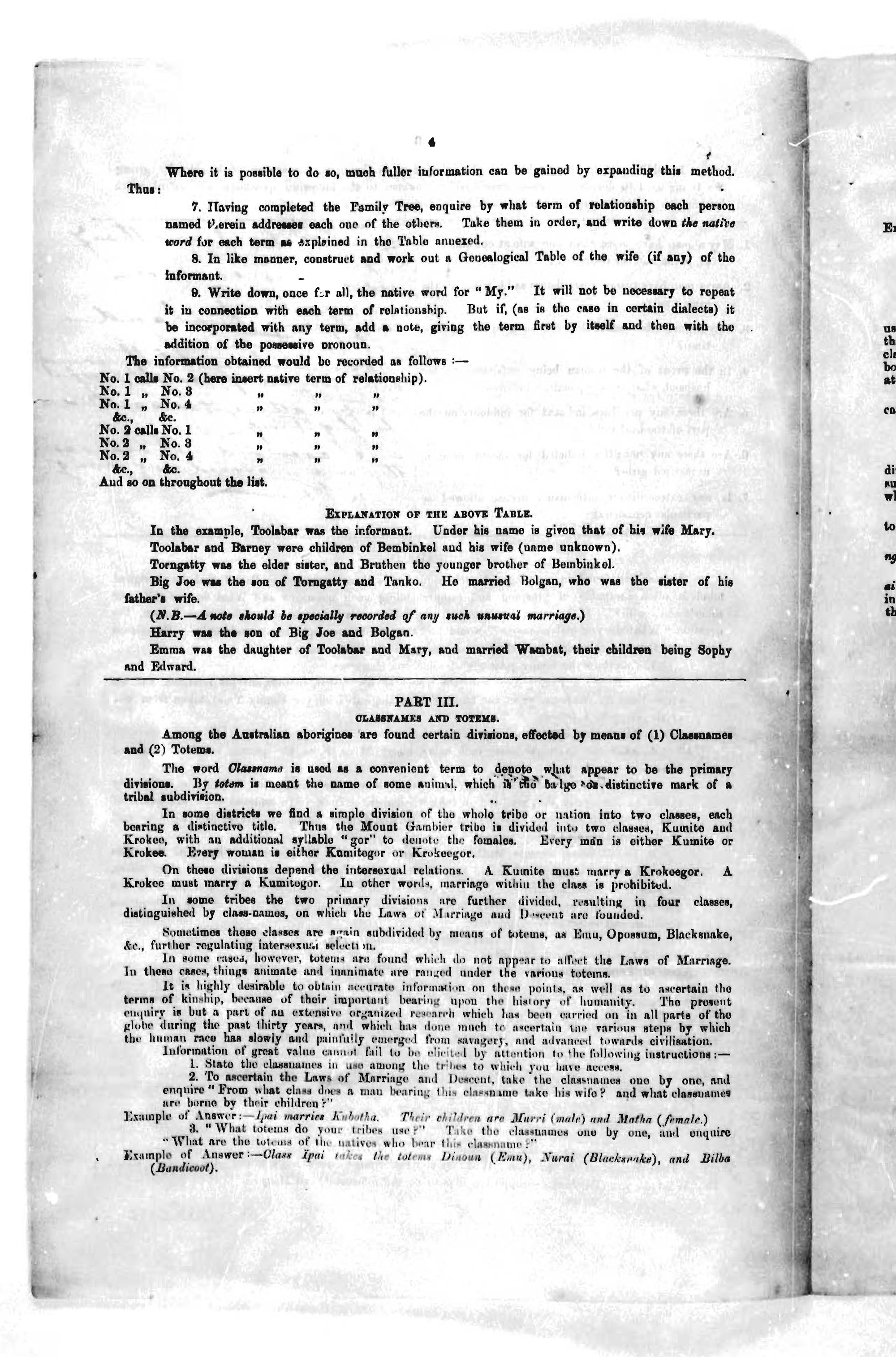Questionnaire sent to Rev Stahle

Transcription - Page 3
4
Where it is possible to do so, much fuller information can be gained by expanding this method.
Thus:
7. Having completed the Family Tree, enquire by what term of relationship each person
named therein addresses each one of the others. Take them in order, and write down [italics: the native word]
for each term as explained in the table annexed.
8. In like manner, construct and work out a Genealogical Table of the wife (if any) of the informant.
9. Write down, once for all, the native word for "My". It will not be necessary to repeat
it in connection with each term of relationship. But if, (as is the case in certain dialects) it
be incorporated with any term, add a note, giving the term first by itself and then with the
addition of the possessive pronoun.
The information obtained would be recorded as follows:-
No. 1 calls No. 2 (here insert native term of relationship).
No. 1 " No. 3 (ditto)
No. 1 " No. 4 (ditto)
&c., &c.
No. 2 calls No. 1 (ditto)
No. 2 calls No. 3 (ditto)
No. 2 calls No. 4 (ditto)
&c., &c.
And so on through the list.
EXPLANATION OF THE ABOVE TABLE.
In the example, Toolabar was the informant. Under his name is given that of his wife Mary.
Toolabar and Barney were children of Bembinkel and his wife (Name unknown).
Big Joe was the son of Torngatty and Tanko. He married Bolgan, who was the sister of his
father's wife.
([Italics: N.B. - A note should be specially recorded of any unusual marriage.])
Harry was the son of Big Joe and Bolgan.
Emma was the daughter of Toolabar and Mary, and married Wambat, their children being Sophy
and Edward.
[Line across page]
PART III
CLASSNAMES AND TOTEMS
Among the Australian aborigines are found certain divisions, effected by means of (1) Classnames and (2) totems.
The word [Italics: Classnames] is used as a convenient term to denote what appear to be the primary
divisions. By [Italics: totem ] is meant the name of some animal, which is the badge or distinctive mark of a tribal subdivision.
In some districts we find a simple division of the whole tribe or nation into two classes, each
bearing a distinctive title. Thus the Mount Gambier tribe is divided into two classes, Kumite and
Krokee, with an additional syllable "gor" to denote the females. Every man is either Kumite or
Krokee. Every woman is either Komitegor or Krokeegor.
On these divisions depend the intersexual relations. A Kumite must marry a Krokeegor. A
Krokee must marry a Kumitegor. In other words, marriage within the class is prohibited.
In some tribes the two primary divisions are further divided, resulting in four classes,
distinguished by class-names, on which the Laws of Marriage and Descent are founded.
Sometimes these classes are again subdivided by means of totems, as Emu, Opossum, Blacksnake,
&c., further regulating intersexual selection.
In some cases, however, totems are found which do not appear to affect the Laws of Marriage.
In these cases, things animate and inanimate are ranged under the various totems.
It is highly desirable to obtain separate information on these points, as well as to ascertain the
terms of kinship, because of their important bearing upon the history of humanity. The present
enquiry is but a part of an extensive organised research which has been carried on in all parts of the
globe during the past thirty years, and which has done much to ascertain the various steps by which
the human race has slowly and painfully emerged from savagery, and advanced toward civilization.
Information of great value cannot fail to be elicited by attention to the following instructions:-
1. State the classnames in use among the tribes to which you have access.
2. To ascertain the Laws of Marriage and Descent, take the classnames one by one, and
enquire "From what class does a man bearing this classname take his wife? and what classnames
are borne by their children?"
Example of an answer:- [Italics: Ipai married Kubotha. Their children are Murri (male) and Matha (female.)]
3. "What totems do your tribes use?" Take the classnames one by one, and enquire
"What are the totems of the natives who bear this classname?"
Example of Answer:- [Italics: Class Ipai takes the totems Dinoun (Emu), Nurai (blacksnake), and Bilba (Bandicoot)].
Document Details
